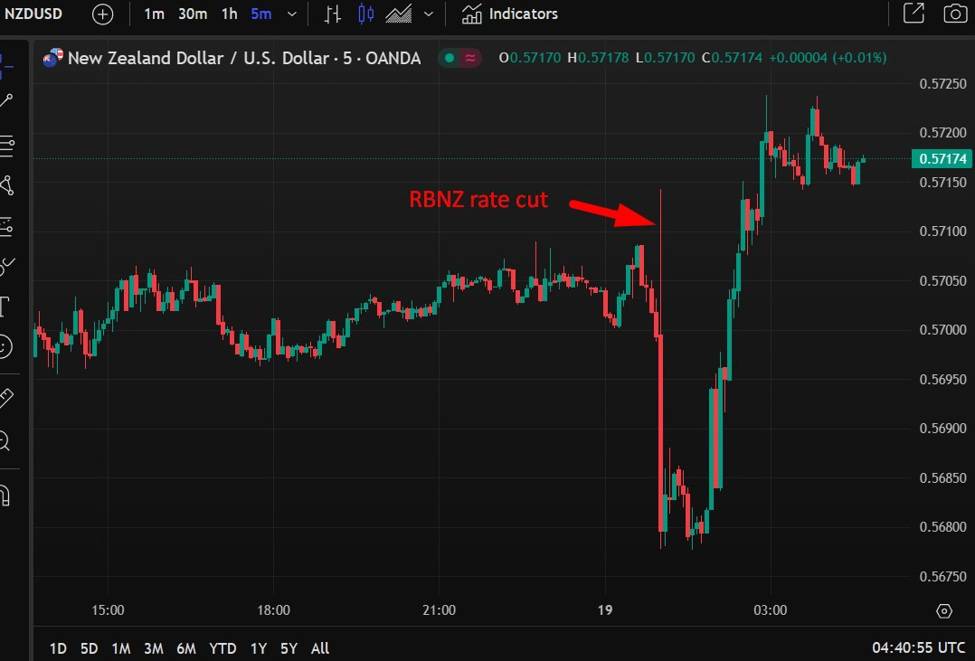RBA’s latest rate decision and market reaction
The Reserve Bank of Australia (RBA) has announced a widely expected 25-basis-point cut to the official cash rate, bringing it down to its lowest level in months. This decision aligns with market forecasts, as economists and analysts had largely anticipated the move given recent economic indicators. However, the central bank refrained from providing any strong signals regarding further easing, leaving investors and businesses uncertain about the future trajectory of monetary policy.
Governor Michele Bullock’s recent statements suggest that the Reserve Bank of Australia is maintaining a cautious and data-driven approach to future monetary policy decisions. While the 25-basis-point rate cut was widely anticipated, Bullock refrained from providing any definitive guidance on the likelihood of further reductions. Instead, she emphasised the importance of ongoing economic data in shaping the central bank’s next moves.
Some economists believe that unless economic conditions deteriorate significantly, the RBA may hold off on further rate adjustments in the near term. The central bank’s decision reflects a balancing act between supporting economic growth and managing inflation risks, which remain a key concern for policymakers. As a result, speculation now turns to upcoming economic data releases, which could influence the RBA’s stance in future meetings.
In her latest remarks, Bullock acknowledged the persistent inflationary pressures but reiterated that the central bank remains committed to steering inflation back within its target range. She highlighted that while some price pressures have eased, particularly in goods inflation, services inflation remains stubbornly high. This has led the RBA to adopt a wait-and-see approach, assessing whether inflation will continue to decline at a sustainable pace before considering additional rate cuts.
Inflation concerns and labor market resilience
Key areas of focus include wage growth and consumer spending trends, both of which influence inflation dynamics. A sustained rise in wages without a corresponding productivity boost could add to inflationary pressures, potentially delaying further rate cuts. Conversely, any signs of weakening consumer demand could prompt the RBA to reconsider its stance and provide additional monetary support.
For forex traders, the uncertainty surrounding the RBA’s next steps means heightened volatility in the Australian dollar. Any shifts in market sentiment based on economic releases or Governor Bullock’s commentary could trigger sharp movements in AUD pairs. As a result, traders should remain vigilant, closely monitoring key economic reports and central bank communications for clues on how policy may evolve in the coming months.
Given these factors, the RBA faces a delicate balancing act between supporting economic growth and ensuring inflation does not become entrenched. While the latest rate cut was aimed at providing some relief to borrowers, the central bank remains cautious about acting too aggressively in easing policy. Future decisions will likely depend on upcoming inflation reports and employment data, as policymakers seek clearer signals on whether inflationary pressures are abating or if further intervention is necessary.
Market expectations for additional cuts have now diminished, with traders factoring in a more measured approach from the RBA. Swaps pricing suggests that investors are no longer fully convinced of another near-term rate cut, particularly given the strength in the labor market and lingering inflationary pressures. This has led some analysts to believe that the RBA may now adopt a “wait-and-see” approach before committing to further policy moves.
Governor Bullock’s outlook and future policy direction
With inflation still above target and employment figures holding strong, traders will closely monitor Governor Michele Bullock’s upcoming remarks for any hints on the central bank’s next steps. For now, the absence of explicit easing signals suggests that the RBA is not in a hurry to cut rates further, keeping the Australian dollar and local markets on edge.
Inflation remains a key concern for the Reserve Bank of Australia, as price pressures persist across several sectors of the economy. Despite the recent rate cut, inflation has yet to show significant signs of easing, with cost-of-living pressures continuing to weigh on households. The latest data indicate that while headline inflation has moderated slightly, core inflation—which strips out volatile items—remains stubbornly above the central bank’s target range. Rising costs in housing, energy, and services have been particularly persistent, challenging the RBA’s efforts to bring inflation back within its preferred range.
At the same time, Australia’s labour market remains surprisingly resilient, complicating the central bank’s policy decisions. Unemployment levels have held steady at historically low rates, and job creation remains robust despite higher borrowing costs. Wage growth, a critical factor in the inflation outlook, has been stronger than expected, further supporting consumer spending. While higher wages provide relief for workers facing rising living costs, they also contribute to inflationary pressures, making it more difficult for the RBA to justify additional rate cuts in the near term.
For now, the central bank appears to be prioritising flexibility, avoiding any strong forward guidance that could lock it into a particular policy path. Bullock’s measured tone suggests that while further rate cuts remain a possibility, they are far from guaranteed. The RBA will continue to assess economic conditions on a meeting-by-meeting basis, ensuring that any future decisions align with its goal of achieving price stability while supporting sustainable economic growth.
The Reserve Bank of Australia (RBA) delivered a 25-basis-point rate cut, a move that was widely expected by the markets. This adjustment brings the official cash rate to a lower level, aimed at supporting economic activity amid persistent inflation concerns. However, what stood out was the central bank’s decision to refrain from signaling further easing measures, leaving traders and investors uncertain about the future policy path.
RBA’s rate cut decision and market reaction
Australia’s economic outlook remains a focal point for traders, with inflationary pressures and labor market conditions shaping expectations for the RBA’s next move. Recent data suggests that while inflation has moderated from its peak, it remains above the central bank’s target range, keeping policymakers cautious. At the same time, the labor market continues to show resilience, with unemployment sitting at historically low levels, reinforcing the RBA’s measured approach.
Following the rate cut, the Australian dollar initially saw a brief dip but quickly stabilized as market participants processed the RBA’s cautious stance. Equity markets responded positively, with the ASX 200 climbing as lower interest rates typically provide support for risk assets. However, bond markets exhibited mixed reactions, with short-term yields adjusting downward while longer-term yields remained relatively steady.
Another key area of focus for Bullock is the resilience of the labour market. Despite higher borrowing costs, employment levels have remained strong, with businesses continuing to report labour shortages in certain sectors. She noted that wage growth remains a crucial factor in determining inflation’s trajectory and acknowledged that sustained wage pressures could lead to a more prolonged period of elevated inflation. As a result, the RBA is treading carefully, ensuring that rate cuts do not inadvertently fuel inflationary risks.
“The RBA has chosen to remain cautious, balancing the need for economic support with inflation risks. Without clear forward guidance, markets are left to interpret data releases more closely than ever,” said a senior FX strategist.
Following the announcement, financial markets responded with measured adjustments. The Australian dollar initially weakened against major currencies but later stabilised as investors digested the RBA’s cautious stance. Meanwhile, bond yields saw slight movements, reflecting a tempered reaction from traders who had already priced in the rate reduction. The stock market showed a mixed response, with interest rate-sensitive sectors such as real estate and financials experiencing modest gains.
Economic outlook and Governor Bullock’s guidance
Market participants and economists are closely monitoring upcoming economic indicators, including inflation data and employment figures, for further clues on the RBA’s policy direction. Some analysts believe that unless there is a notable softening in the labour market or a sharper-than-expected decline in inflation, the central bank may hold rates steady in the coming months. Others argue that global economic uncertainties, including slowing growth in key trading partners such as China, could prompt the RBA to reassess its stance if external risks intensify.
Some economists argue that the strength of the labour market suggests the economy is not in urgent need of further monetary stimulus. Job vacancies remain elevated, and businesses continue to report difficulty in finding skilled workers. This tight labour market dynamic has led to concerns that inflation may remain persistent, reducing the likelihood of further rate reductions in the coming months. Moreover, global economic conditions, including ongoing supply chain disruptions and geopolitical tensions, add to the uncertainty surrounding inflation trends.
Governor Michele Bullock’s upcoming statements will be closely scrutinized for any indications of future policy direction. So far, the central bank has emphasized a data-dependent stance, avoiding firm commitments to additional rate cuts. This has left traders navigating an environment where economic indicators carry even greater weight in shaping market expectations.
“The RBA is walking a fine line between managing inflation risks and supporting growth. Without clear forward guidance, markets will be highly sensitive to upcoming economic data,” noted a macroeconomic analyst.
Despite the rate cut, expectations for additional easing have diminished. Analysts point to the RBA’s neutral tone in its statement, which suggests a wait-and-see approach rather than a commitment to further reductions. Market participants had been looking for explicit guidance on the possibility of more cuts, but the central bank opted to maintain flexibility, likely in response to persistent inflationary pressures and resilience in the labour market.

